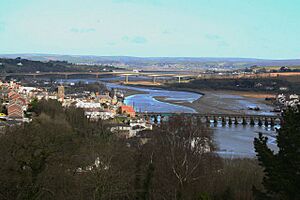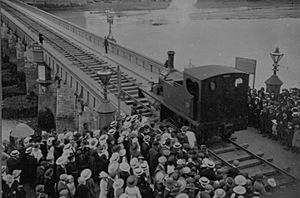Bideford Long Bridge facts for kids
The Bideford Long Bridge is a very old and famous bridge in North Devon, England. It crosses the River Torridge near where the river meets the sea. This bridge connects the old town of Bideford on the west side with East-the-Water on the east side.
It is one of the longest medieval bridges in England. It stretches 677 feet (about 222 yards) and has 24 arches. In 1790, it was the longest bridge in all of Devon. For a long time, it was the last bridge you would cross before the river reached the sea. That changed in 1987 when the Torridge A39 Road Bridge was built further downstream.
The river under the bridge is still affected by the tides. This means the water level changes a lot twice a day. A fun old tradition on New Year's Eve was to try and run across the bridge while the church bells of St. Mary's rang at midnight. In winter, many people enjoy watching huge groups of starlings gather under the bridge at dusk to sleep.
The Bideford Long Bridge is a very important historical building, listed as Grade I. Another large medieval bridge, the Barnstaple Long Bridge, is just a few miles away. You can see a big model of the Long Bridge, showing how it changed from 1280 to 1925, at the Burton at Bideford museum.
Contents
History of the Bridge
The Bideford Long Bridge has a long and interesting history, starting with a wooden structure and later becoming the stone bridge we see today.
From Wood to Stone
Historians believe the first bridge here was built in the late 1200s. It was made from strong oak wood. The sections between the supports were not all the same length. This was because they used whatever lengths of timber they had.
Later, in the 1300s, the bridge was rebuilt using stone. The stone arches were built around the wooden bridge, using it like scaffolding. This is why the stone arches are not all the same width. They match the varying lengths of the original wooden beams.
There are also other ideas about why the arches are different sizes:
- Some say each arch was paid for by a different local group, called a guild. So, they were built bit by bit.
- Others believe the supports for the arches were built on large, natural stones already in the river. These stones were in random places.
We know a bridge existed early on because a bishop named Walter de Stapledon left money in his will in 1326 to help maintain Bideford Bridge.
Building the Stone Bridge
The stone bridge we see today was mostly paid for by Sir Theobald II Grenville. He was a powerful lord who owned land in Bideford and Cornwall. He probably helped build the bridge in the 1300s.
Other families also donated money, and many people in the area helped. One historian even said he saw a list of all the people who gave money or help. It was a huge community effort! The bridge was not near a main road at the time. So, it was likely built mainly for the people living in Bideford.
Bishops from Exeter also helped by asking people to donate money for the bridge. They even offered special blessings to those who helped build or repair it. This shows how important the bridge was to the community.
The bridge was considered very tall for its time. Small ships could pass under its arches, even if they had to lower their masts. There's a story that the bridge's foundations were built on wool bales. This is probably just a legend, showing how important the wool trade was back then. In reality, the foundations are very strong.
A Legendary Beginning
Before the bridge was built, crossing the wide and sometimes rough river was dangerous. Many people drowned.
A local priest named Richard Gornard had a dream. In his dream, he was told to start building a bridge near a rock that had rolled down from the hills onto the riverbank. The next morning, he found a huge rock. It was so big that he felt it must have been placed there by God.
This inspired him to start building the bridge. He convinced Sir Theobald Grenville, the local lord, to help. The priest told the Bishop of Exeter about his dream. The Bishop then asked everyone in the area to donate money or help with the work.
People were very happy to help. Important people gave money or land, and ordinary people gave weeks or even months of their time. Everyone worked together to build this important bridge. Bishops continued to offer blessings to anyone who supported the bridge, encouraging everyone to help with such a good project.
Widening and Changes
For a long time, barges (flat-bottomed boats) used to pass under the bridge. They would travel two miles upstream to Weare Giffard with the incoming tide. They carried things like stone, sand, and coal. On the way back, they brought wood, fuel, and grain.
In the 1820s, there was a plan to turn the bridge into a drawbridge. This would allow the middle section to be lifted so that taller ships could pass through. However, this plan was never carried out.
The bridge was made wider in 1865 and again in 1925 to handle more traffic.
How the Bridge Was Managed
For many years, a group called the Bideford Bridge Trust was in charge of the Long Bridge. They looked after it until 1968.
In the early 1600s, the townspeople took the trust to court. They said the trustees were using the bridge's money for parties and plays instead of repairs. The townspeople won the case!
In 1968, one of the bridge's arches collapsed. After that, the government's Department of Transport took over responsibility for the bridge. You can find out more about the bridge's history in a booklet called 'The Long Bridge of Bideford Through the Centuries'.
The Bridge During World War II
During World War II, the 10th arch of the bridge was being repaired. The police asked for ladders and scaffolding to be removed from the bridge. This was to stop any potential invaders from climbing up and capturing the bridge. During the war, the local Home Guard patrolled the bridge to keep it safe.
Images for kids






